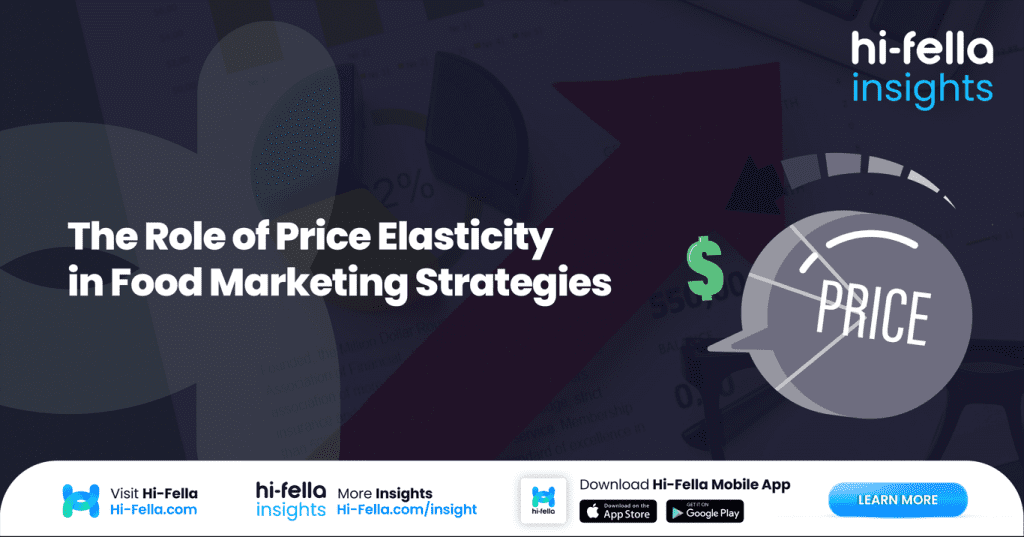In the dynamic and ever-evolving world of food marketing, one concept quietly shapes product launches, promotional campaigns, and pricing models—yet most people outside the industry have never heard of it. Enter price elasticity. It’s not just a term economists throw around in stuffy classrooms. For food marketers, understanding price elasticity is like having a secret map to consumer behaviour.

But let’s not make this boring. We’re diving deep into how price elasticity can be your best ally (or worst enemy) when crafting food marketing strategies. Whether you’re in FMCG, plant-based startups, or the gourmet snack world—this concept deserves your attention.
So, What Is Price Elasticity, Really?
Let’s break this down like we’re in a chill café chat—but with business brilliance.
Price elasticity of demand (PED) is a core concept in economics that shows how much the quantity demanded of a product changes when its price changes. Think of it as a sensitivity gauge: how jumpy are your customers when you tweak your prices?
The formula is pretty straightforward (but don’t worry, we won’t go all textbook on you):
Price Elasticity of Demand=% Change in Quantity Demanded% Change in Price\text{Price Elasticity of Demand} = \frac{\%\text{ Change in Quantity Demanded}}{\%\text{ Change in Price}}Price Elasticity of Demand=% Change in Price% Change in Quantity Demanded
Here’s What It Means in the Real World:
- Elastic Demand: If a small drop in price leads to a significant increase in demand, your product is said to be elastic.
👉 Example: If you reduce the price of a soft drink by 10%, and sales shoot up by 30%, congratulations—you’re playing in elastic territory. - Inelastic Demand: If even a big change in price barely affects how much people buy, the product is inelastic.
👉 Example: Raise the price of salt by 20%, and people still buy it—because let’s be real, nobody’s skipping salt. That’s inelastic behaviour.
Why Does This Matter in Food Marketing?
Because elasticity dictates how you price, promote, and grow.
Knowing whether your product is elastic or inelastic lets you answer crucial questions smartly:
- Should you run a price-based promotion or focus on brand value?
- Will a price hike help you increase profits or drive away your customers?
- Is bundling or discounting going to help you capture more market share—or just lower your margins?
Let’s Put It in Action: A Quick Case Study
Case: Premium Plant-Based Milk vs. Regular Cow’s Milk
Let’s say you’re launching an oat milk brand at RM13 per litre, competing against regular cow’s milk priced at RM6.
- For plant-based consumers who are vegan, lactose intolerant, or health-conscious, your oat milk may be a necessity, not a luxury. So even if you raise the price to RM15, many will still buy it. This shows relatively inelastic demand within that niche.
- But for general shoppers without dietary restrictions, they might only try oat milk when it’s on sale. Lower the price to RM10, and suddenly they’re curious enough to switch. Raise it again, and they go back to cow’s milk. That’s elastic demand among casual buyers.
Now imagine you’re planning a marketing campaign. If you don’t understand elasticity:
- You might waste budget discounting a product people already value and would pay full price for.
- Or worse, you might raise prices and lose your price-sensitive customers without a fallback plan.
That’s why elasticity is your strategy compass—it helps you navigate price changes with purpose, not guesswork.
More Everyday Examples of Elastic and Inelastic Food Products
| Product | Type | Elasticity | Why? |
| Bottled Water (branded) | Essential, but has substitutes | Elastic | Easy to switch brands if price goes up |
| Organic Baby Food | Niche, health-driven | Inelastic | Parents pay more for perceived safety and quality |
| Snack Chips | Impulse-buy, crowded category | Elastic | Promotions drive major sales spikes |
| Rice | Household staple | Inelastic | Core necessity, price change has minimal effect on quantity |
| Artisanal Cheese | Premium indulgence | Varies | Can be elastic for casual buyers, inelastic for foodies |
A Smart Tip for Marketers
Elasticity is not fixed—it can change over time, depending on:
- Brand positioning
- Consumer income
- Availability of substitutes
- External factors (like inflation or supply shortages)
This means you can shift your product along the elasticity spectrum. For example:
- Build a strong brand and story to reduce elasticity.
- Innovate with packaging or format to increase perceived value.
- Run education-based campaigns to move your product from an indulgence to a “daily must-have.”
Elasticity isn’t just an economics concept—it’s a marketing power tool. Use it well, and you can make your pricing strategy work for you, not against you.
Elastic vs. Inelastic: The Snack Bar Showdown
Let’s put this into context. Imagine you sell snack bars:
- Your high-protein, keto-friendly snack bar probably targets a niche health-conscious audience. They value ingredients and branding, not just price. That means it’s relatively inelastic—you can increase the price moderately without losing them.
- But your mass-market chocolate-coated snack bar? That’s elastic territory. A small price drop during back-to-school season might send sales skyrocketing, especially if you’re competing in supermarket aisles.
Understanding this difference can dictate everything from discount strategies to packaging decisions. Genius, right?
What Influences Elasticity in Food Products?
Here’s where it gets really juicy. Several factors shape the elasticity of your food product:
Brand Loyalty
If your brand has strong loyalty (like Oatly, Ben & Jerry’s, or Yakult), you’ve got more wiggle room on price. People aren’t just buying your product—they’re buying into your story, your values, and how you make them feel. That’s marketing gold.
Availability of Substitutes
No substitutes? Less elastic. Tons of options? Way more elastic.
A luxury truffle oil may have no clear substitute in the eyes of foodies. But potato chips? Consumers will bounce to another brand the second the price tag jumps.
Necessity vs. Indulgence
Staples like rice, bread, or cooking oil are often price inelastic, especially in lower-income markets. Meanwhile, fancy desserts or limited-edition lattes are more price sensitive, making them ripe for discount experimentation.
Income Levels of Target Market
High-income consumers care less about price changes, which means premium brands can afford to play with pricing without scaring customers away. But if you’re marketing affordable instant noodles to students—price sensitivity is real.
How Smart Marketers Use Elasticity in Real Life
Alright, now we’re talking strategy. Here’s how savvy food marketers apply elasticity thinking in real-world campaigns:
1. Dynamic Pricing Based on Season or Occasion
When demand is less elastic—say, around festive seasons or product launches—marketers often raise prices slightly or bundle products to increase perceived value.
👉 Example: Mooncakes during Mid-Autumn Festival. Everyone buys them, even at premium prices.
2. High-Impact Discounting for Elastic Products
For products with high price elasticity, marketers schedule strategic discounts that create volume spikes without eroding brand value. The goal? Short-term volume, long-term loyalty.
👉 Example: Ice cream brands pushing BOGO offers in summer heatwaves.
3. Premium Branding to Reduce Elasticity
Strong brand equity reduces price sensitivity. By investing in storytelling, sustainability, or health claims, brands make their products feel worth it, regardless of cost.
👉 Example: An organic multigrain snack that highlights clean labels and kid-friendly nutrition becomes less about price and more about values.
4. Product Line Diversification
Offering multiple SKUs at different price points allows marketers to tap both elastic and inelastic segments.
👉 Example: Launching both a budget-friendly granola and a gourmet “artisan blend” version.
Elasticity in the Digital Era: Real-Time Response
In today’s digital-first landscape, marketers don’t need to guess how elastic their products are. With e-commerce analytics, A/B pricing tests, and real-time feedback, you can test, learn, and iterate faster than ever.
Tools like Shopify, Google Analytics, or even marketplace insights from Lazada or Shopee let you observe elasticity in action. Smart marketers track cart abandonment rates, discount response curves, and price comparison behaviour to tweak strategies instantly.
Wrapping It Up: Elasticity = Empowerment
Understanding price elasticity isn’t just about tweaking numbers—it’s about understanding people. It helps you speak their language, meet their needs, and deliver value in ways that go beyond price tags.
If you’re a food marketer who wants to:
- Craft smarter promotions,
- Create loyal customers,
- And maximise revenue without cheapening your brand,
… then mastering price elasticity is non-negotiable.
Next-Level Moves: Join Hi-Fella and Stay Ahead
Want to take your food marketing game to the next level? Whether you’re a supplier launching the next big health snack, or a buyer sourcing unique products for your platform—Hi-Fella is your partner in navigating the complexity of modern food trade
In a world where price elasticity guides every smart decision, having the right data and the right connections makes all the difference.
🎯 Join Hi-Fella today and get the marketing edge you didn’t know you needed.







